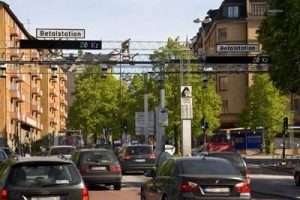Strategies to reduce traffic congestion and the associated GHG emissions can be characterized as either being driven upwards by individual jurisdictions or imposed downwards by national authorities.
In the case of Stockholm, Sweden’s largest city, the approach has been clearly bottom-up. The city decided on its own initiative to charge a congestion fee for vehicles entering the city core. With few exceptions, charges would vary by time of entry and departure with no in-and-out privileges. Revenue would be directed to improve public transit.
It sounds simple enough. However, getting Stockholm to that stage was far from straight forward.
Gunnar Söderholm was one of five key individuals responsible for setting Stockholm’s congestion charge in motion. He told a recent Transport Futures Mobility Pricing conversation that prior to the start of trials in 2006, 80 per cent of Stockholmers were opposed to the idea. Of the 320,000 people employed in the city centre at the time, over 210,000 commuted from outside every day. It was regarded as another tax imposed on an already heavily-taxed population.
Many called the idea “political suicide,” a “catastrophe.”

However, Söderholm said the drop in traffic volume was noticeable immediately, decreasing 25 per cent during the trial. Half of those travellers chose public transportation. The other half “disappeared” either into fewer trips or travel times outside the charge periods.
Stockholm is a city of islands connected by bridges. This simplified the monitoring of traffic, allowing the placement of 18 unmanned electronic control points or gateways. Furthermore, expansion of public transit ahead of the trial offered a practical alternative for personal travel. For example, 200 buses and 20 new suburban express routes were added.
Immediately after the trial ended, traffic volumes returned to normal. However, Stockholmers didn’t like that. Once congestion charges were established on a permanent basis in 2007, Söderholm said public support stabilized at around 70 per cent, a level of support seen in other major cities around the world that have also instituted a congestion charge.
Congestion charges per entry or departure were set low at first, topping out at the equivalent of C$9 per day no matter how many crossings. Fees have increased over time, and today are capped at the equivalent of C$13.50. Charges don’t apply overnight, on weekends and during holiday times. It should also be pointed out that parking can be as much as C$50 per day in Stockholm’s core.
Söderholm said no one wants to return to the way things were before. Noise, congestion and pollution have been dramatically reduced, even as Stockholm’s population has grown. Inner city travel time has been reduced by 50 per cent. Public transit buses run on time.
“We were lucky,” he said, “not geniuses.”
Upcoming Mobility Pricing Conversations include:
- “Whither the Gas Tax?” with Harry Kitchen, Trent University (Nov. 30 @ 1pm):
- “Forging a Path to US Road Usage Charging” with Randal Thomas, Oregon Department of Transportation/RUC America (Dec. 7 @ 1pm)
- “Putting Parking in its Proper Place” with David King, Arizona State University (Dec. 14 @ 1pm):
- “Transit Fare Policy Challenges and Strategies” with Brendon Hemily, Hemily & Associates (Dec. 19 @ 1pm)







Recent Comments